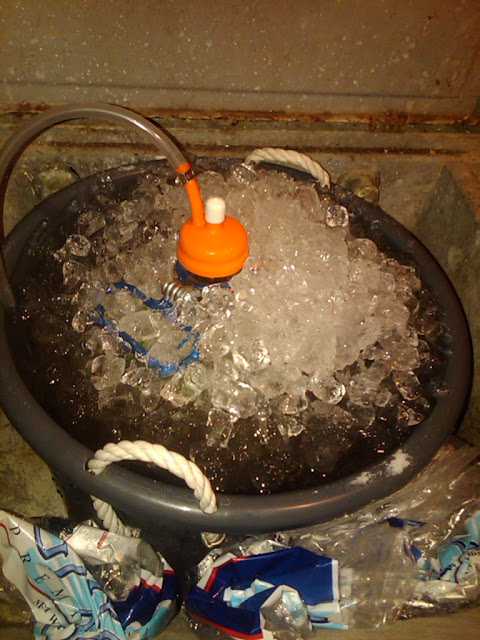So I am not sure that I have the equipment to cold crash it...would racking it to a secondary slow it down enough?
Cold crashing does not take much equipment, just some extra space in the refrigerator and an extra carboy. Rack the cider off the yeast cake, chill it for a couple days at as near freezing as you can get it, and then rack it back to a keg for force carbonation or the original container if you want to let it clear and/or keep an eye on it for a while to verify that the cold crash stopped it. If you keep your keg cold, then you dont have to worry if got out all the yeast in the crash, because any remaining ones will be slowed way down.
I have racked ciders without crashing before to slow them down. I do that because sometimes two ciders taste ready to go at the same time and I only have space in the fridge to cold crash one. It does slow the ale yeast batches down enough to delay the crash for a few days. Every once in a while a single rack can cause the fermenation to stop for low nutrient juice, but usually it starts back up. The yeast cake provides a lot of nutrients.
the easiest method is to catch it at the correct FG, pasteurize the whole batch (in bulk or in bottles), then add the proper amount of bottling sugar and yeast, and bottle.
If you stop the fermentation before terminal FG and then pasteurize, DO NOT add any more yeast. You can drink it still or force carbonate. If there is any fermentable sugar besides the priming sugar and you add more yeast, you will get burst bottles.
the common potassium sorbate and potassium metabisulfite DO NOT stop an active fermentation in its tracks.
I've been able to stop ferments up to 1.010 with kmeta and sorbate, but I wouldnt recommend it. I did a 16-batch experiment a few years ago with S04 yeast and varying amounts of kmeta and sorbate vs cold crashing. At least half a dose of kmeta, stirred and allowed to absorb for about 15-30 min, followed by full dose of sorbate will stop the fermentation, but that much sorbate leaves an aftertaste that I dont like - sort of a medicinal vanilla and baby aspirin taste. Some of my friends were OK with it. It seemed to me like the taste of sorbate would work better in a root beer. If you take a tiny bit from the jar it comes in, and put it on your tongue, thats the taste. It doesnt go away. If it doesnt bother you, then you have no worries, I try to avoid it.
cvillekevin had at one point talked about suspecting the removal nitrogen to stop fermentation in a commercial operation, but that he didn't know how you could accomplish something like this on a home brewer scale.
Its a little tricky, but doable. I've done seven batches using nutrient reduction to bottle carb a sweet cider and havent burst any bottles yet, knock on wood. I wrote about it a few months ago. You need low nitrogen juice (which is most organically grown juice), a yeast that uses a lot of nutrients, like a wheat yeast (I've had good results with Wy3333) and a way to contain bottle spills in case they do burst. You may also need to do some experimenting to find the right yeast that works with your juice.
I do find you can make a great backsweetened draft cider using concentrated fresh pressed cider juice.
If you keep your kegs cold you have a lot of options. If you use an ale yeast, you will gain the same benefit as cold crashing, the yeast will go dormant and stay that way as long as you dont lose power. Even lager yeasts, which are nearly impossible to crash, will slow way down in a cold keg. Just drink at bit every few days and if it feels like too much pressure is building up, let some out
I ordered a commercial fridge about a week ago. It should be here in another week. It fits in the same space as my old fridge but is taller so it will fit 2 kegs and 2 carboys at the same time. I'll be able to cold crash two batches at a time if I need to and still get my drank on. true temp control so I should be getting more consistent crashes, plus I wont freeze my kegs and accidentally make applejack whenever the basement gets real cold. I'm lookin forward to apple harvest season, presses should be starting up in a few weeks.




